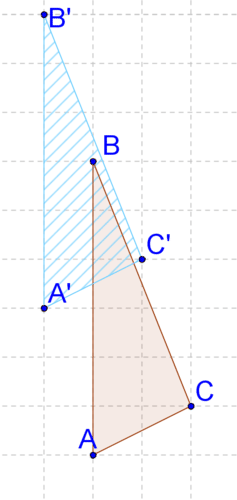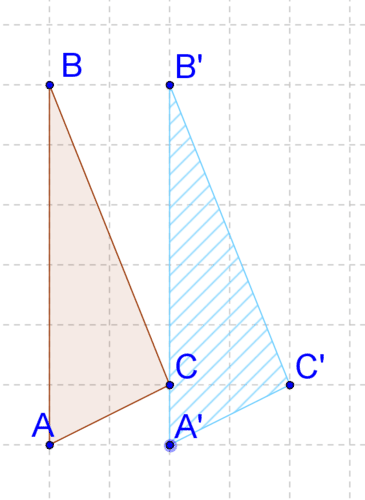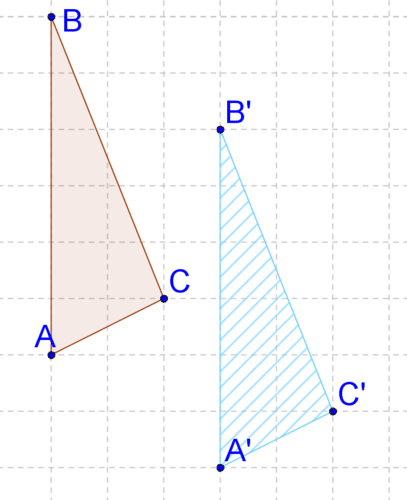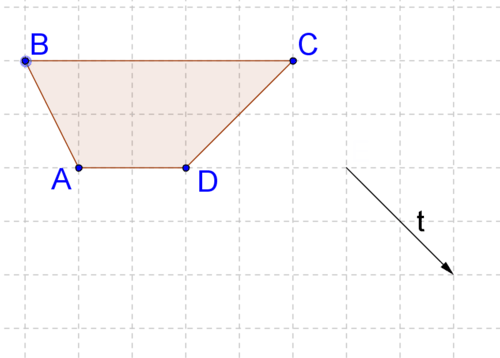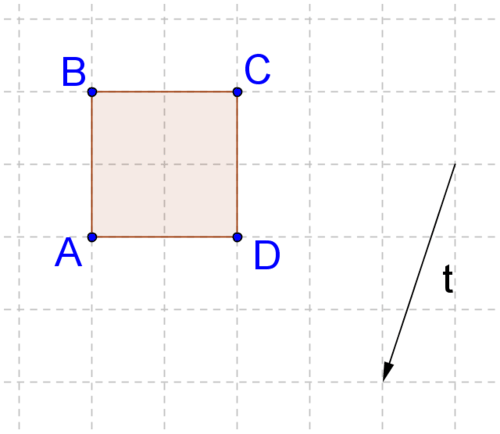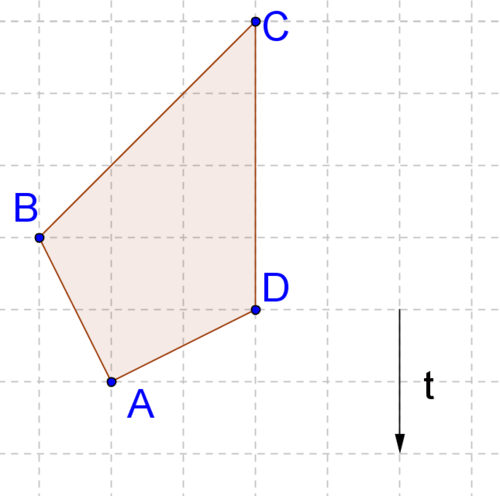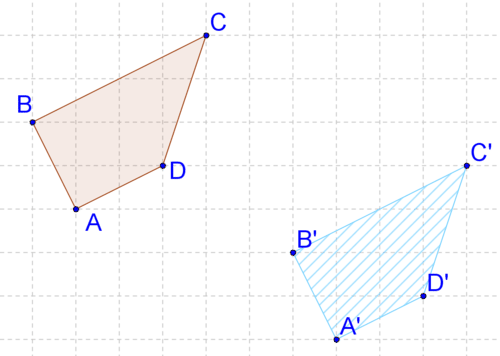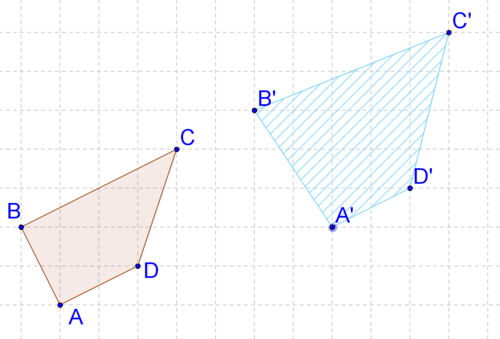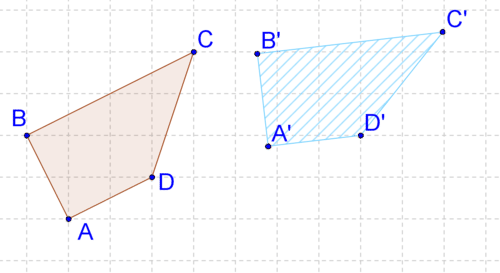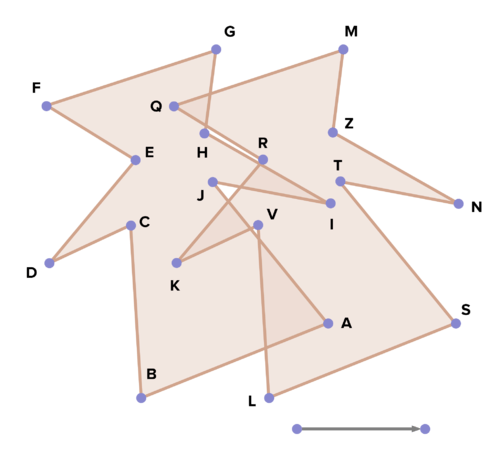笔译翻译
Section outline
-
Translations
::笔译翻译In Latin, the word "translate" means "carried across". A translation moves ("slides") an object a fixed distance in a given direction, as defined by a vector.
::在拉丁文中, “ translate” 一词是指“ 绕过” 。 翻译移动( “ slides” ) , 对象在矢量定义的某一方向的固定距离 。-
Translations do not change the size or shape of an object, and
do not
rotate
or flip
it.
::翻译不改变对象的大小或形状,也不旋转或翻转对象。 -
The original object is called the pre-image, and the translation is called the image.
::原始对象称为预映像,翻译则称为图像。 -
An object and its translation have the same shape and size, and
face
in the same direction.
::对象及其翻译的形状和大小相同,面朝同一方向。 -
A translation is one example of a
rigid transformation
.
::翻译是僵硬转换的一个例子。
Below, the parallelogram has been translated along vector to create a new parallelogram (the image).
::以下将平行图ABCD转换为矢量 v, 以创建新的平行图A_B_C_D(图像)。-
Note
that the location of vector
does not matter, but the slope (the
angle
of the vector compared to the grid) does matter.
::注意矢量 v 的位置无关紧要,但斜坡(矢量与网格的角)则无关紧要。 -
Vectors have a direction and a magnitude (a length)
. They can be thought of as directions
for moving
points from
preimage
to image.
::矢量有一个方向和一个音量( 一个长度) 。 它们可以被视为从预映到图像的移动点的方向 。 -
Vector
essentially tells you that all points move three units to the right and one unit up.
::矢量 v 基本上告诉你所有点 向右移动三个单位 向上移动一个单位
The lines that connect corresponding points will all be parallel to vector .
::连接相应点的线条将全部与矢量 v平行。T he slope of vector and each line is . This should make sense because each point in the original was moved 3 units to the right and 1 unit up to create its corresponding point in the image.
::矢量 v 和每条线的斜坡是13。 这应该有道理,因为原点的每个点都被移到右边3个单位和1个单位,以便在图像中创建相应的点。One way to think about translations is that they move points a specified distance along lines parallel to a given line. In this case, all points were moved a distance of (found using the Pythagorean Theorem) along lines parallel to vector .
::一种思考翻译的方法是,他们沿着与给定行平行的线条移动指定的距离点。 在这种情况下, 所有点点都被移动到与矢量 v... 平行的线条上10= 32+12( 使用 Pytagoren Theorem 发现) 。Notice that lines parallel to vector have been drawn through each of the original points. Vector has been copied onto each of those lines at the points that define the original quadrilateral . The ends of the vectors define the points on the image .
::注意与矢量 v 平行的线条已经通过每个原始点绘制。 矢量 v 已被复制到其中每个线条的点上, 用于定义原始四边形。 矢量的端点会定义图像上的点 。
Recognizing Translations
::确认翻译Is the following transformation a translation?
::以下的转换是翻译吗?One way to check if a transformation is a translation is to look at how each point moves to create its image. If all points are not moving in the same way, then it is not a translation.
::检查转换是否为翻译的一种方式是查看每个点如何移动以创建图像。 如果所有点不是以相同方式移动, 那么它不是翻译 。Point to Image Point
::点对图像点Description of Motion
::动议说明to
::A至A`至A'4 to the right and 5 up
::右4对4, 向上5to
::B 至 B 的 B 字4 to the right and 5 up
::右4对4, 向上5to
::C 到 C 的 C 至 C4 to the right and 6 up
::右边4至4, 右边6至6to
::DtoD4 to the right and 5 up
::右4对4, 向上5Because to is different, this is not a translation .
::因为C到C是不同的, 这不是翻译。Is the following transformation a translation ?
::以下的转换是翻译吗?The above transformation is
::上述转变是。
CK-12 PLIX: Translation Notation
::CK-12 PLIX: 翻译符号
Describing a Translation Vector
::翻译矢量Describe the vector that defined the translation below.
::描述定义以下翻译的矢量。The vector moved each point four units to the right and five units up.
::矢量将每个点向右移动4个单位,向上移动5个单位。Describe the vector that defined the translation below.
::描述定义以下翻译的矢量。The vector moved each point
::矢量移动每个点 。
Performing Translations
::进行翻译Observe how the translation defined by vector is performed on the quadrilateral below.
::观察下方四边形如何进行矢量 u定义的翻译。With the grid in the background, you can see that vector tells you to move each point 2 units up and 1 unit to the left.
::在背景的网格中,您可以看到矢量 u 指示您将每个点 2 单位向上移动, 1 单位向左移动 。Here is the translation :
::以下是翻译:
Translation
::笔译 笔译-
Use the dropdown selector to s
elect a shape to translate to a new location.
::使用下拉式选择器选择将形状转换为新位置的形状。 -
Explore different distances and directions of translation by clicking or tapping the blue arrow and then dragging any of the orange
vertices
of the shape that appear.
::点击或点击蓝箭头,然后拖曳形状出现的任何橙色顶点,从而探索不同的距离和翻译方向。
Shape:
Triangle
::形状:三角形
Examples
::实例实例实例实例Example 1
::例1Translations are often informally called "slides". Why is this?
::翻译通常被非正式地称为“滑坡”。为什么这样?A translation is informally called a slide because it essentially slides a shape to a new position. The orientation and relative position of the points does not change.
::翻译被非正式地称为幻灯片, 因为它基本上向新位置的形状幻灯片。 点的方向和相对位置不会改变 。Example 2
::例2Perform the translation defined by vector ( ) on the triangle below.
::在下方三角形上执行矢量 t (t) 定义的翻译 。Since indicates 1 unit to the right and 3 units up, each of the points and should be translated by that amount.
::由于t++表示右侧有一个单位,上方有三个单位,A、B和C点各应按这一数额翻译。Hover or tap translation to see the translation in action.
::误差或自译自审,以看到翻译在实际操作中。Summary -
A
translation
is a rigid transformation that moves ("slides”) an object a fixed distance in a given direction, as defined by a vector.
::翻译是指在矢量定义的某一方向移动物体(“滑动”)固定距离的硬质变换。 -
Translations do not change the size, shape, or orientation of an object.
::翻译不会改变对象的大小、形状或方向。 -
Vectors
have a direction and a magnitude, and they can be thought of as directions for moving points from preimage to image.
::矢量有一个方向和一个规模, 它们可以被视为从预感向图像移动点的方向。 -
To check if a transformation is a translation, ensure that all points are moving in the same way.
::要检查变换是否为翻译, 请确保所有点都以同样方式移动 。
Review
::审查审查审查审查1. Is a translation a rigid transformation? Explain.
::1. 翻译是否是一种僵硬的转变?2. What role does a vector play in a translation?
::2. 矢量在翻译中起什么作用?3. How are parallel lines relevant to translations?
::3. 与翻译相关的平行线如何?4. How can you tell if a transformation is a translation?
::4. 你如何知道转换是否翻译?Describe the vector that defined each of the following translations.
::描述定义以下各译文的矢量。5.
6.
7.
8.
Perform the translation defined by vector on the polygons below.
::在以下多边形上执行由矢量 t 定义的翻译。9.
10.
11.
12.
Are the following transformations translations? Explain.
::下面的转换是翻译的吗?13.
14.
15.
16. A translation moves an object along a vector. A vector is a directed line segment that tells us how far to move the object, and in what direction. It's the signpost that tells the object where to go. In the diagram below, there are several vectors which are independently used to translate polygon C. Match each vector with the correct image. Explain your results.
::16. 翻译在矢量上移动对象。矢量是一个指示线段,它告诉我们移动对象的距离、方向和方向。是指示对象去向的标牌。在下面的图表中,有若干矢量独立用于翻译多边形 C。将每个矢量与正确的图像匹配。请解释您的结果 。17. For visualizing translations of polygons, it can be useful to connect vertices of the original polygon to the corresponding vertices of the image by drawing a copy of the vector used for translation. It is not necessary to connect all of the corresponding vertices, just one pair is usually sufficient. Which two points would you connect to visualize the translation below? Why did you choose those two points? What would be your second choice of corresponding points? Why?
::17. 对多边形的可视化翻译而言,通过绘制用于翻译的矢量副本,将原始多边形的顶点与图像的相应顶点连接起来可能是有益的,不必将所有对应的顶点都连接起来,通常只需要一对即可。您将哪两个点连接到下面的可视化翻译上?为什么您选择这两个点?为什么您要对相应的顶点作第二种选择?为什么?
18. Sketch a line. Sketch a vector such that the image of the line after translation by the vector is the original line. Does a point on the original line map to itself? Does the line map to itself? Explain.
::18. 绘制一条线。 绘制一条矢量, 使矢量翻译后的线的图像成为原始线。 原始线图上的某个点是否属于原线图本身? 线图本身是否属于该线图本身? 解释 。19. Sketch a line. Sketch a vector such that the image of the line after translation is not the same as the original line. What relationship do these lines have? Why?
::19. 绘制一条线,绘制一条矢量,使翻译后线的图像与原线不同,这些线有什么关系?为什么?20. Sketch a circle. Translate the circle by a vector that maps only one point on the original circle to a point on the new circle.
::20. 绘制一个圆形。将圆形用一个矢量转换为新圆形上的一个点,该矢量只绘制原圆上的一个点的原始圆形图。21. The point is translated by a vector such that its image is . This image is then translated again so that its image is . Is there one single vector that would accomplish these two translations in one step? Describe it in terms of its horizontal and vertical components.
::21. 点(2.3)由矢量翻译,其图像为(5,4),然后再翻译,其图像为(7,9),然后再翻译,其图像为(7,9),是否只有一个矢量可以一步完成这两个翻译?用横向和纵向成分来描述。Review (Answers)
::审查(答复)Click to see the answer key or go to the Table of Contents and click on the Answer Key under the 'Other Versions' option.
::单击可查看答题键, 或转到目录中, 单击“ 其他版本” 选项下的答题键 。 -
Translations do not change the size or shape of an object, and
do not
rotate
or flip
it.
